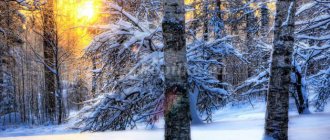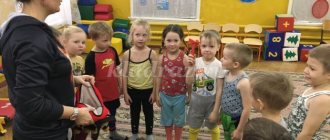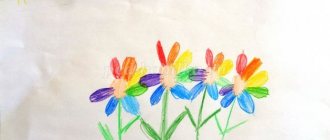Personal website of Valentina Nikolaevna Bulygina
The fourth week of January was dedicated to the theme “Home. Kuban courtyard." The children looked at pictures and illustrations on the theme “Houses”, “Fairy-tale houses”, “Kuban hut”, “Houses of different nations”; what materials were previously and are modern houses built from? We conducted a lesson to familiarize ourselves with the world around us, “This Wonderful World,” where we summarized children’s knowledge about various types of housing.
At a speech therapy lesson, the fairy tale “The Three Bears” (adapted by L.N. Tolstoy) was retold based on a series of pictures. We read, retold and looked at pictures from the fairy tale “The Three Little Pigs” in books.
We watched the cartoons “About Construction” and “Special Equipment”.
Cartoon "The Three Little Pigs".
We conducted drawing classes on the theme “Fairytale Houses” and on the fairy tale “The House of the Three Little Pigs.”
The final stage was a theatrical game on the theme “The Three Little Pigs”.
Summary of the theatrical game in the senior group on the theme: “The Three Little Pigs”, 01/30/2018.
Objectives: To teach children to understand the emotional figurative content of a fairy tale, its idea, and to compose a story according to the scheme. To develop children’s desire to create images in theatrical play, to use intonation, dance, song, and play improvisations, to convey the character of the characters in the fairy tale.
Preliminary work: Examination of pictures and illustrations on the theme “Houses”, “Fairytale houses”, “Kuban hut”. Reading, retelling, looking at pictures in books based on the fairy tale “The Three Little Pigs.” Watching cartoons on TV: “About Construction”, “Special Equipment”, “The Three Little Pigs”. Drawing “Fairytale Houses”, based on the fairy tale “The Houses of the Three Little Pigs”.
Material: Three little pigs' flat houses, circus house, piglets' hats, wolf costume, diagrams.
Move
Children approach the house, stand in a semicircle, and greet the builder.
Educator: What a beautiful house you built, round, bright, I just want to look into it. Is this a circus?
In our Anapa, many new houses have been built for people to live in, many shops, but the circus comes only in the summer. Why?
Builder: Look in my folder, read the diagrams, tell a story based on them and you will understand everything.
The folder contains diagrams for the fairy tale “The Three Little Pigs.”
Educator: Now we will analyze the schemes one by one and begin.
Children take the diagram under number 1, then under number 2 and so on, for a total of 5 schemes. Five guys take part, the rest sit down as spectators in the hall and prepare for the performance, changing clothes.
- Once upon a time there were three little pigs, three brothers. (On the card there are three circles with two holes in each - spots).
- All of the same height, round, pink, with the same tails. (On the card there are 3 large pink circles, inside of which there are small circles with two holes in each and a hook-tail drawn from the large circle).
- Even their names were similar. The piglets' names were Nif-Nif, Nuf-Nuf and Naf-Naf. (Names are printed on the cards.)
- All summer they tumbled in the green grass, basked in the sun, and basked in puddles. (On the card there is sun, grass, puddles).
- But then autumn came. (On the card there is a tree without leaves, bending from the wind, clouds).
Educator: Well done, guys, you told the beginning of the fairy tale, now we’ll see what happened next.
The children who told the story sit down, and the child artists show the story.
Educator: All summer the piglets had fun, basked in the sun, basked in puddles.
Children wearing pig hats go out into the middle and dance to cheerful music.
Educator: Naf-Naf once said to his brothers.
Naf-Naf: It's time for us to think about winter, I'm shaking all over from the cold. Let's build a house and spend the winter in it all together.
Sketch ( the piglets answer their brother). Children dressed as pigs lift their houses from the floor - straw, twig and brick, and show the child spectators the fairy tale to the end.
Educator: Well done guys, it turned out to be an interesting game. Who guessed why the circus comes to us only in the summer?
It’s true, the city doesn’t yet have a warm, strong building for it so that the artists don’t freeze in winter.
01/31/2018 at 22:51. Headings: Classes, Photos.
Construct based on the theatrical game “The Three Little Pigs” under the direction of Lyudmila Petrovna Temereva
Age group:
middle group (4-5 years)
Kind of activity:
theatrical activity
Subject:
theatrical game "The Three Little Pigs"
Form of organization:
group
Planned result:
Children negotiate in the process of distributing roles and planning play space;
Children show interest in theatrical play;
Children cooperate in the process of implementing the game plan;
Children perform simple performances based on familiar literary works: “The Three Little Pigs.”
Target:
developing children's skills for joint play activities
| Tasks | Tasks taking into account the characteristics of the group’s students |
| Educational tasks : Develop the ability to negotiate in the process of distributing roles and planning the playing space; Develop self-confidence and positive self-esteem in the process of joint gaming activities. Developmental tasks: Continue to develop and maintain children’s interest in theatrical play by acquiring more complex skills; Training tasks: Teach children to perform simple performances based on familiar literary works: “The Three Little Pigs”; To develop the ability to cooperate in the process of implementing a game plan. |
Principles of preschool education (FSES DO):
- full-fledged experience by the child of all stages of childhood (infancy, early and preschool age), enrichment (amplification) of child development;
-building educational activities based on the individual characteristics of each child, in which the child himself becomes active in choosing the content of his education, becomes a subject of education (hereinafter referred to as individualization of preschool education;
-formation of cognitive interests and cognitive actions of the child in various types of activities; age adequacy of preschool education (compliance of conditions, requirements, methods with age and developmental characteristics).
Principles of education:
creating a positive emotional uplift, developing a personal style of interaction with peers and teachers, education through interaction.
Game equipment:
-a book of the fairy tale “The Three Little Pigs”, figures of game characters (three little pigs, a wolf), attributes (houses for piglets, trees), cards for drawing lots (4 cards of fairy tale heroes, 6 cards with a chair).
Game roles:
pig Nif-Nif, pig Naf-Naf, pig Nuf-Nuf, wolf
Preliminary work:
Reading the fairy tale “The Three Little Pigs.”
Educational and methodological kit:
Federal state educational standard for preschool education. / Ministry of Education and Science of the Russian Federation, order dated October 17, 2013 N 1155.
Summary of educational activities for speech development in the senior group. Visiting the fairy tale “The Three Little Pigs”
Lesson on speech development with children of the senior group of preschool educational institutions.
Topic: “Visiting the fairy tale “The Three Little Pigs”” Topic: “Visiting the fairy tale “The Three Little Pigs”. Goal: To create a condition for activating the vocabulary based on adjectives and plurals in preschool children. Objectives: Educational:
To help consolidate children’s knowledge about the fairy tale “The Three Little Pigs” and enrich their vocabulary.
Developmental:
Develop speech activity, encourage children to engage in dialogue.
Educational:
Develop the ability to listen to each other and act together.
Auxiliary material: Theatrical houses, masks, table, dishes, pictures of clothes, a large box equipped with levers and devices. Preliminary work: Reading Russian folk tales; playing out the fairy tale “The Three Little Pigs” using a didactic game, solving riddles. Forms of work: Create a positive environment, set up children to work together and divide children into subgroups. Methods: Visual - Plot pictures based on a fairy tale. Verbal - Conversation. Practical – Phys. minute “Building a house” Game: Into the characters of the fairy tale “The Three Little Pigs” Vocabulary work: Selection of adjectives: “A chair made of wood - wooden”, “potato soup - potato”, “a glass made of glass - glass”.
Progress of educational activities
Children enter the hall, say hello, stand in a semicircle Educator: Good morning, guys. Let's smile at each other. And say hello! Educator: Guys, today we have a not quite ordinary lesson, a fabulous one. I invite you to take a trip to a fairyland. The teacher asks the question: How will we get there? Children's answers: On a rocket, on a plane, on a train, on a bus, on a flying saucer. Educator: I suggest you go on a trip in a “time machine.” Let's see if she's ready to take us to a fairyland. Hop into our “time machine” and let’s see if it will transport us! (The teacher and the children approach the “Time Machine” (a large box with different levers and devices)
. Guys, what words need to be said so that our “time machine” will take us to the magical land of fairy tales?
(in chorus)
“One, two, three, To visit a fairy tale, transport us! So we are transported to a fairyland to our fairy tale!
Alyonushka comes out. Alyonushka: Hello guys, I am the mistress of a magical land of fairy tales. There are many, many fairy tales in my country. Today we will visit one of them. Let's guess the riddle, and by the answer you will understand what kind of fairy tale it is. Riddle: A village in the middle of the forest_ Three brothers were building. The wolf watched with interest as they quarreled. He decided to eat them, but it didn’t work out_ Only in vain did he climb onto the roof. The wolf ate their legs carried away Singing his gray tail. Singing a song loudly Having fun…………. Children's answer: “The Three Little Pigs" Educator: That's right, this is the fairy tale “The Three Little Pigs". And today we will visit them. Alyonushka leads the children to the house: And at home What kind of houses did the piglets have? Game exercise “What kind of houses did the piglets have?” (children select adjectives: Nif has Nif made of straw, Nuf-Nuf made of branches, and Naf has Naf made of bricks and stones (strong, clean, cozy. ) Alyonushka: What materials are houses built from? (children's answers.) GAME “Which house” (with a ball)
.
House made of wood - wooden From brick - brick From stone - stone From concrete - concrete From clay - clay From cardboard - cardboard From ice - ice From straw - straw From panel - panel From plastic - plastic. Educator: I suggest you rest a little. Phys. minute “We are standing the house” One, two, three, four, five. (Children jump on the spot)
Let's build and play.
We are building a big, tall house. (They stand on their toes and stretch their arms up)
We install windows and build a roof.
(Show the window and the roof with your hands - close your hands)
What a beautiful house!
(They extend their arms forward with an indicative gesture)
We will live with you in it!
(Squat down) Alyonushka: Piglet Naf - Naf invited his brothers to his housewarming party, there were dishes on the table. Poll about dishes. There was soup poured into the bowls. What do you guys think the soup was made from? Game exercise “What soup is made from” From mushrooms - mushroom, From fish - fish, From vegetables - vegetable, From potatoes - potato, From beets - beetroot, From carrots - carrot. Educator: Guys, look at this plate, there is only one, but when there are many of them, then let’s say: many plates; One glass, and when there are many of them... many glasses; One spoon...many spoons; One table...many tables; One chair...many chairs. One door…..many doors. One window…..many windows. Alyonushka: The piglets ate soup. I decided to change clothes and go for a walk. Guys, who knows what clothes are made from? Game “What are the clothes made of ” (the teacher shows pictures, the child names what kind of clothes they are)
Linen trousers - linen trousers, a coat made of wool - a woolen coat, a dress made of chintz - chintz, a scarf made of silk - silk, a hat made of fur - fur.
Educator: Thank you Alyonushka, you told us a fairy tale. And now our guys will show how they can play the characters of this fairy tale. Three pigs and a wolf are chosen from among the children: Children stand in a circle. The teacher touches one of the children. Child: “Oh, you hit me on the back, so I’ll be the Wolf.” The wolf selects piglets from among the children: “Come on, we need to see if you will be a piglet with us” (the one who is touched becomes a piglet)
.
We choose another piglet. Child is the first pig: “I’ll spin around and stand up straight, so you can be the second pig.” We choose the third pig. The child is the second pig: “Come on, he’ll have to be a pig.” The Wolf child puts on a wolf mask, and the piglet children wear piglet masks on their heads. The piglets sit on the edge of the forest and sing a song: “We are not afraid of the wolf...” Imitating the voice of a wolf. Piglet (speaks in a menacing voice)
: “Aren’t you afraid?
Now, as soon as I blow it, your house will fall apart.” The piglets run away, and the wolf catches up with them (we play 3 times)
.
Alyonushka: Well done guys. Thank you for visiting me in a fairyland. And I give you this wonderful book of fairy tales. Well, now hit the road. Goodbye, guys. Educator: Thank you Alyonushka. But it's time for us to return to kindergarten. (Children get into the Time Machine)
.
- Let's say the magic words again: “One, two, three, take us to kindergarten!” So we returned to kindergarten. Summary Guys, let's remember. - Where have we been today? What did we do there? What games did we play? Guys, I really enjoyed traveling with you through a fairyland. We will visit different fairy tales with you. And now we’re going to look and read a new book.
We recommend watching:
Lesson on speech development and familiarization with the environment in the senior group. Summary of a lesson on speech development for children in the senior group. Topic: “How winter meets spring” Summary of a lesson on speech development for older preschoolers Summary of a lesson on speech development in the senior group for children with a stutter: Winter fun
Similar articles:
Summary of a lesson on speech development in the senior group. Retelling of a work of art. Ushinsky “Medicine”
Summary of a lesson on speech development in the senior group. Funny riddles
Lesson notes on speech development in the senior group
Lesson summary on the topic “Relationships in the family.” Senior group
Lesson on emotional development in the senior group



